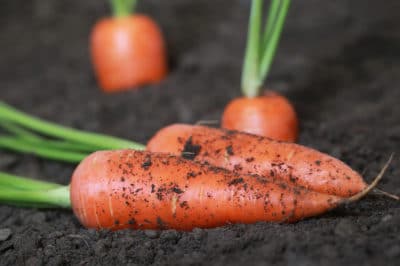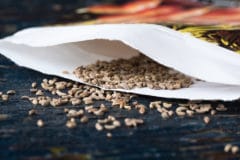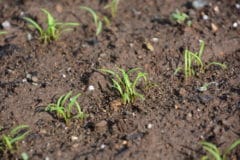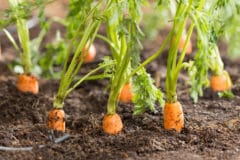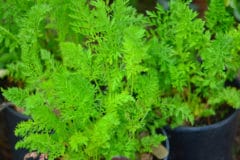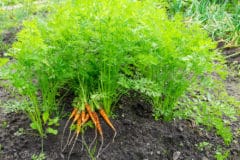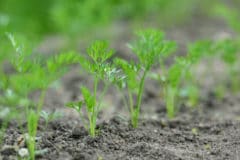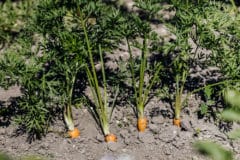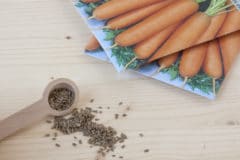Where should I plant my carrots?
Carrots crave sunshine, and plenty of it. Your carrot patch should be situated in a part of your garden that gets lots of sun. Minimal shade is okay, but not too much. Let your carrots soak up those rays for the best possible harvest.
How should I prepare my garden to grow carrots?
Proper preparation of your soil is paramount to growing carrots. Carrots require soft, loose soil to grow in; put them in packed earth and you’ll end up with small, round balls instead of the long, luscious carrots you’re expecting.
Once you’ve determined where in your garden to plant your carrots, till the soil deeply. Your carrots will extend deeply into the earth and they need to be able to do so easily. Till to a depth equal to the mature size listed on your seed packet; eight or more inches is probably best.
If you run across rocks while tilling, remove them. They can interfere with your plants pushing through the soil as they grow.
Note: The Danvers variety of carrot is able to grow in slightly denser soil than most carrots, but thorough and deep tilling is still your best bet.
Do I need to fertilize before planting?
Once you’ve tilled your carrot patch, you can add some organic fertilizer or compost.
- Phosphate and potassium are good for root growth, so they’re a good choice.
- Nitrogen encourages foliage growth, not root growth. Carrots don’t need added nitrogen, so be careful when using fertilizer.
- Don’t use manure to prep your soil; it can cause forking and side-roots, which will negatively impact the plant.
- Limit the amount of fertilizer you use before planting. Excess fertilizer will make your carrots less tasty.
When should I sow my carrot seeds?
Once your garden is ready to be planted, it’s time to put your seeds out. That’s right; carrots go straight into the ground, no transplanting necessary.
Seeds should be sown three to five weeks before the last expected spring frost. Plant your seeds in rows, three to four inches apart from each other and place a layer of mulch over your new plantings; this will speed up germination and protect roots from all that direct sunlight.
What kind of care do my carrot seeds need?
Carrots are not a labor intensive plant. Sufficient water, some fertilizer or compost added periodically, and plenty of sunshine are all these tubers need to grow happily.
Once your seedlings reach one inch tall, you will need to thin them. Use scissors to snip unwanted starts at ground level; pulling them might disturb the root systems of nearby seedlings. Thin enough that your carrots are spaced about three inches apart; this will allow for maximum growth potential.
About six weeks after you’ve started your carrots, go ahead and fertilize them with some compost or other organic matter, again, avoiding manure. If you’re using a commercially available product, look for something without nitrogen but plenty of potassium and phosphate for strong, robust roots.
Do be sure to pull weeds frequently, since you don’t want your water and nutrients to be diverted away from your carrot crop.
What about pests and insects?
Carrots are largely immune to diseases and bugs, but there are a few things to watch for.
Carrot root fly larvae will result after carrot flies lay their eggs on the ground near your carrots. If your area is prone to these insects, your best option is a physical barrier around your carrots. A mesh cage structure, at least two feet tall, will keep both carrot flies and their offspring away from your plants.
Flea beetles can appear if your carrot plot is near woody areas. These are often sent packing with a dusting of play talcum powder or diatomaceous earth, or with white sticky traps. There are many home-made remedies on the internet, too.
Aster yellow disease is spread by pests, plant-to-plant and garden-to-garden. Pest control is your best bet to avoid discolored, short, unhealthy foliage and hairy roots in your carrots.
When can I harvest my carrots?
Your carrots are ready to harvest when they’re about 2 ½ months old, as long as they are at least half an inch in diameter. Leaving them longer will, of course, allow them to grow larger.
It’s possibly to harvest your carrots earlier; baby carrots are quite popular. Realize that over-harvesting early in the season means less harvest of mature vegetables.
When harvesting carrots, gently loosen the soil around each plant with a garden fork, and pull carefully. Don’t dig about or “stir” the ground to loosen your carrots; this will damage the roots of nearby plants that are not yet mature.
How do I store my harvested carrots?
Simply putting freshly pulled carrots into the refrigerator is not the optimal way to store your tubers. They’ll wilt in a matter of days, and the flavor will also begin to fade.
If you want to store your fresh carrots, you can still refrigerate them after proper preparation. Remove the foliage by twisting, then scrub your carrots clean with running, cold water. Allow your clean carrots to dry and then seal them in airtight bags or containers and put them in the fridge.
You can also leave your carrots in the ground, provided your ground won’t freeze. Several inches of shredded leaves or other good mulch will help protect your carrots while you wait to harvest them.
Harvested carrots can be kept in large containers filled with moist sand for storage in the winter. Of course carrots can also be cleaned, chopped if desired, blanched, and packaged for the freezer; they’ll last months this way!
Can I grow my carrots in containers?
Yes!!! Provided your pots are deep enough, and that you give your carrots enough water and sunshine, they’ll thrive in pots as easily as in the ground. Nantes and Little Finger Nantes carrots are a good variety for growing in pots, as they grow to be only about six inches long.
You can even grow carrots indoors! Plant them in pots and be sure they get plenty of sun, and you can have those beautiful, green carrot tops adorning your home while having carrots on hand whenever you want.
One of the benefits of raising carrots in pots is that you can “chase the sun,” moving them around as the season latens to ensure they get as much sunlight as they can.
What else should I know about growing carrots?
You can plant your carrots in shifts, every two or three weeks, which will allow you to harvest until late in the year.
Carrots are pretty frost-resistant vegetables; in fact, they are tastier after a frost or two. For this reason, leaving them in the ground once they’re mature is a great idea!
As a biennial plant, carrots will produce their own seeds for you! Leave a few in the ground at the end of the season and in their second year, they’ll produces flowers and seeds. Imagine, a self-perpetuating garden!
Carrot tops can be grown into houseplants or decorative outdoor foliage. Just cut the tops off your carrot (green leaves intact) and set them in a bowl or dish of water. Roots will show up quickly, and when they’re established you simply plant the entire thing in soil. This is a great first project for young gardeners!
Carrots are a healthful vegetable that are easily grown. With colors ranging from orange to red to purple and even white, they offer a bright spot in many meals, while being low in calories and sodium and very high in vitamin A.
A small amount of effort can result in a large harvest that will keep you in carrots for months. Insect and bug resistance come naturally to this root vegetable, making them easier and less demanding to grow; in addition, they make great companion plants for beans and tomatoes.
Overall, whatever variety you choose to grow, or what you’ll use them for, carrots are a great addition to any garden.
